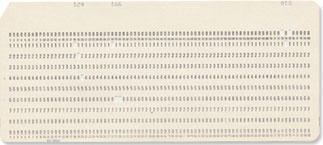
To understand the modern digital file, one must accept that the image or sound (and so forth) no longer consists of a physical trace of the object represented; instead, it is a virtual, numerical representation of that object. Following this definition, the first digital image can be traced back to 1801, when Jean-Marie Jacquard (French weaver and inventor, 1752-1834) demonstrated an automated loom whose actions were directed by a program stored on punched cards, a precursor of the computers of the 1960s, which stored their programs on cards of this nature. These cards contained information encoded on them by a series of holes punched in specific locations, like those in the rolls of a player piano. The information on the cards, the presence or absence of a hole in a particular spot, would determine the movements of the loom to weave together the threads, and thus the pattern of the cloth that the loom produced. Jacquard also produced a self-portrait on the loom, encoded on 10,000 cards used to weave the portrait. We can consider this image digital insofar as it represented the image with discrete units, and required the intervention of an interpretive machine—the loom—to create the image from stored data. Charles Babbage (English mathematician and philosopher, 1791-1871) was directly influenced by Jacquard's use of cards, and it is said that he had a portrait of Jacquard hanging on the wall of his office.
